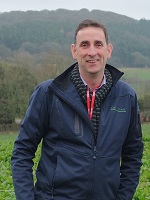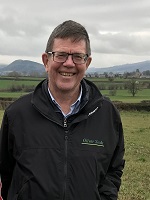Published
24 .May.2021Grass and forage trends
Oliver Seeds forage experts talk about the changes in grassland management they are seeing across the country
East of England - Rod Bonshor

Erratic weather conditions over the past few years from heavy snow to drought, have made many farmers in the East of England reconsider what the best grass and forage species and combinations are.
The case is definitely becoming stronger for species that are robust enough to withstand climatic extremes and that do not have an over-reliance on artificial nitrogen fertiliser. Last spring demonstrated that deep-rooted species such as cocksfoot and festulolium offered exceptional spring growth, while ryegrass was very slow to grow away.
Many arable farmers are looking for different crop options due to their poor experiences growing oilseed rape. They might do well to talk to dairy farmer neighbours to see what crop growing synergies can be found. It might suit them well if fodder beet, maize, arable silage, lucerne or a red clover ley could be grown for animal feed and these could all act as excellent soil-conditioners ahead of a first wheat.
There is a trend towards herbal leys, where the diversity of species has many benefits for soil health and condition, particularly in the dry East. Deep-rooted herbs and legumes such as chicory, plantain, red clover, lucerne, sainfoin, burnet, sheep’s parsley and yarrow have an important role to play, not only in soil health but also in the health of grazing livestock. There is a definite desire to seek a wider nutritional base from grazed herbage than can be achieved in a one-species dominant sward.
There are also opportunities for grass leys to help both dairy farmers and hay producers. It is often easier for the dairy farmer to take the first ‘fleshy’ cut as silage, leaving the potentially drier regrowth for baling as hay when the weather is more suited for hay making. This would also help arable farmers gain some weed control over fields with heavy blackgrass infestations as this does not enjoy such ‘bullying’.
The last trend that offers possibilities for dairy farmers is to use cover crops on arable farms. Many of the species included in these mixtures such as vetch, crimson clover and cereals offer useful grazing, including for heifers and youngstock.
South West England - John Harris

No matter what type of dairy enterprise be it an extended grazing operation or one with all-year-round-housed cows, provision of high-quality palatable forage is crucial.
Growing quality forage has certainly moved up the priority list and more time is now spent developing a whole-farm approach to this aspect, including soil management, nutrient planning, broadleaved weed control and crop rotations.
All this is being planned with new and complex thoughts in mind, like how to reduce the carbon footprint of dairy farming and how to increase carbon sequestration into soils.
On a farm level, there are increasing discussions about how to establish forage crops such as rape, kale and turnips without ploughing. These crops offer a proven way to break the pest and disease cycles before establishing new leys. There are different ways of sowing these seeds – but selecting the right operator and machine for the job, is vital.
With more direct drills available I am expecting to see continued interest in direct drilling grass seed. This idea should take a planned approach – not seen just as a short cut to getting more grass to grow in a previously poorly performing field.
Although livestock plays the major role in the South West, many mixed farmers are now increasing the use of cover crops in arable rotations, rather than leaving bare stubbles.
There is also more interest in sowing multi-species leys. Some farmers are taking advantage of environmental schemes such as GS4 (Legume and herb-rich swards), but this is by no means the whole market.
A growing number of farmers are dipping their toe into the herbal leys water, including plantain and/or chicory in standard perennial ryegrass and clover swards. They are seeing the benefits they bring in terms of drought tolerance and nutrition, but there still remains the issue of weed control.
North West England - Donald Boyd

There is growing awareness of farmers in this area for the need to maximise grazed and conserved grass quality. In general some farmers are looking to take more silage cuts, but not many have gone into a full multi-cut system.
There is also more interest in growing higher protein crops such as lucerne or red clover to reduce reliance on bought-in protein. This is from a cost perspective and also a recognition that most products such as soya, are transported large distances around the world.
There is growing recognition that regular monitoring of sward performance is essential. Systems such as AgriNet are being used, mainly by low-cost, spring calving herds, to help monitor grass growth in fields across the season, and to compare one farmer's fields with others in the locality.
There is also more interest in looking at overseeding to maintain grass performance but reducing the time the field is out of production, compared to a full reseed. Direct drilling grass is also gathering interest as the choice of machines with narrow spacing has increased.
There is greater awareness of the problems of grass to grass reseeds and how to reduce the impact of pests such as leatherjackets and frit fly. Some have used brassicas or undersowing a cereal crop.
Maize is a major crop around here and so undersowing maize with grass or establishing Italian ryegrass after the maize has been cut is being practised in fields in continuous maize. The main reasons are to reduce soil erosion and nitrogen leaching, to make less damage to fields at harvest and also the opportunity to get an extra crop of grass before the next maize crop. This is still at an early stage of development with farmers looking at different systems and mixtures.
The type of swards sown varies greatly. Fewer farmers are sowing short term mixtures due to the cost, but also concerns about heading in dry seasons. Most are using four-to-five-year mixtures based on intermediate and later perennial ryegrasses. Systems based mainly on grazing will favour mixtures including clover, but there is very limited choice of weed control.
Finally, I am finding that more and more dairy farmers are looking for advice on grassland management, as they seek to make the most of the cheapest food source on the farm.
This article was first published in British Dairying in March 2021.
